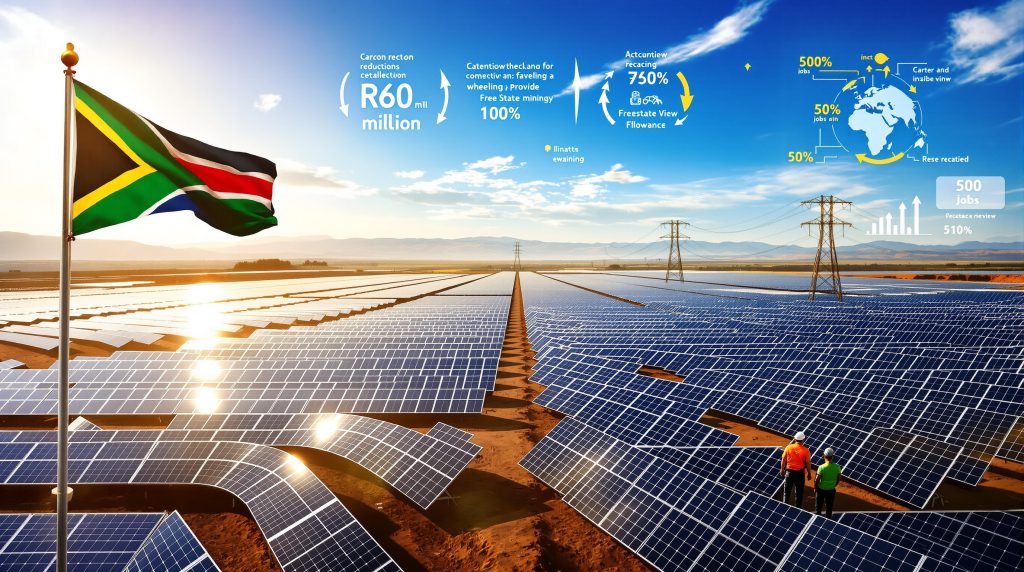How Does the Sibanye-Stillwater Springbok Solar Plant Work?
The 150MW Springbok solar plant stands as a landmark achievement in South Africa's renewable energy landscape, representing a significant advancement in Sibanye-Stillwater's strategy to secure reliable, clean power while reducing operational costs. Located in the Free State province, this innovative facility began commercial operation in October 2025, marking a crucial milestone in the company's journey toward energy independence and carbon reduction.
The plant operates on a pioneering multi-buyer model, with Sibanye-Stillwater serving as the anchor customer by purchasing 75MW (50% of the total capacity) through a 10-year power purchase agreement. This arrangement provides the mining company with approximately 4% of its total South African energy requirements while delivering annual savings exceeding R60 million at current Eskom electricity rates.
Developed and financed by independent power producer SOLA Group, the facility demonstrates how private sector collaboration can effectively address South Africa's ongoing energy challenges while supporting corporate sustainability goals. The project's successful implementation showcases the viability of large-scale renewable energy solutions for energy-intensive mining operations.
What Makes the Springbok Solar Plant a Groundbreaking Project?
Africa's First Multi-Buyer Solar Wheeling Project
The Springbok solar plant represents a revolutionary approach to renewable energy procurement in the mining sector through its multi-buyer wheeling model. This innovative system allows electricity generated at the Free State facility to be "wheeled" or transmitted through Eskom's national grid infrastructure to reach multiple corporate customers at different geographical locations.
SOLA Group announced in April 2025 that the Springbok facility would be "Africa's first multi-buyer solar plant," enabling several major corporations to share capacity through virtual wheeling arrangements. This arrangement demonstrates how multiple companies can benefit from a single large-scale renewable project without requiring direct physical connections.
For the South African mining industry, this model creates a blueprint for collaboration that reduces individual capital burdens while maximizing the benefits of scale. By pooling demand, participants can access renewable energy at competitive rates without assuming the full development risk of standalone projects.
Strategic Location and Technical Specifications
The Free State province offers ideal conditions for solar power generation, with high solar irradiation levels that maximize the plant's output throughout the year. This strategic location ensures optimal performance and reliable energy production to meet Sibanye-Stillwater's operational needs.
The 150MW photovoltaic system utilizes advanced solar technology designed to withstand South Africa's specific environmental conditions, including temperature variations and occasional severe weather events. The facility connects to Eskom's transmission network through dedicated infrastructure that enables efficient power distribution to multiple offtakers.
While specific technical details regarding panel manufacturers, inverter technologies, and tracking systems have not been publicly disclosed, the facility incorporates industry best practices to ensure maximum generation efficiency and operational reliability throughout its lifespan.
What Financial and Operational Benefits Does the Plant Deliver?
Cost Savings and Energy Security
The financial advantages of the Springbok solar plant extend well beyond immediate electricity cost reductions. At current Eskom tariff rates, Sibanye-Stillwater projects annual savings exceeding R60 million, representing significant operational cost relief in an industry where energy typically accounts for 15-25% of total production costs.
More importantly, the 10-year power purchase agreement provides long-term price stability and insulation from Eskom's unpredictable tariff increases. With South Africa's electricity prices having risen at rates significantly above inflation over the past decade, this predictability creates valuable financial forecasting advantages.
Beyond direct cost benefits, the project enhances energy security by reducing the company's vulnerability to load shedding, which has severely impacted mining operations nationwide. By securing independent renewable capacity, Sibanye-Stillwater has established a partial hedge against grid reliability issues that have become increasingly common in the face of energy export challenges.
Carbon Reduction and Environmental Impact
From an environmental perspective, the Springbok facility delivers substantial emissions benefits by displacing coal-based electricity from the national grid. The project is expected to reduce carbon dioxide equivalent emissions by approximately 229,000 tonnes annually, representing around 3.6% of Sibanye-Stillwater's combined Scope 1 and 2 emissions.
This reduction carries increasing financial significance as South Africa implements stricter environmental regulations and carbon taxation. The country's carbon tax, introduced in June 2019, applies to companies emitting more than 100,000 tonnes of CO₂ equivalent annually. While initial implementation included various allowances and exemptions, the tax rate is expected to increase progressively, making emissions reduction projects increasingly valuable.
By establishing renewable generation capacity now, Sibanye-Stillwater positions itself advantageously for a regulatory environment that will likely become more stringent regarding emissions. This proactive approach aligns with the company's commitment to achieve carbon neutrality by 2040, as confirmed by CEO Richard Stewart.
How Was the Project Developed and Financed?
Partnership Structure and Investment Model
The Springbok solar plant exemplifies effective collaboration between mining operations and independent power producers. SOLA Group took the lead in developing and financing the project, leveraging its expertise in renewable energy while allowing Sibanye-Stillwater to focus on its core mining operations.
The multi-buyer business model represents an innovation in project finance for South African renewable energy. By securing multiple offtake agreements, SOLA Group could achieve the scale necessary for competitive pricing while distributing risk across several corporate customers. This arrangement demonstrates the evolving sophistication of South Africa's renewable energy market and the growing viability of corporate PPAs.
This partnership structure reflects a broader trend in the mining industry trends, where companies increasingly look to specialized renewable developers rather than capital-intensive self-build options. The arrangement allows mining companies to secure clean energy without diverting significant capital from core operations or assuming development risks.
Project Timeline and Implementation
The Springbok solar plant achieved commercial operation in October 2025, marking the second renewable energy project in Sibanye-Stillwater's portfolio to come online that year. This milestone followed the successful commissioning of the 89MW Castle wind farm in April 2025, demonstrating the company's systematic approach to implementing its renewable energy strategy.
Together, these projects provide Sibanye-Stillwater with 164MW of operational renewable capacity, forming part of a broader 407MW contracted renewable portfolio. This rapid deployment showcases the accelerating pace of renewable energy adoption in the mining sector and the increasing speed at which utility-scale projects can be implemented.
The successful delivery of both projects within a single calendar year demonstrates the maturation of South Africa's renewable energy industry and its ability to deliver complex projects efficiently, even amid challenging economic conditions and regulatory environments.
What is the Broader Impact on South Africa's Energy Transition?
Social and Economic Benefits
The Springbok solar plant delivers benefits that extend beyond Sibanye-Stillwater's operations to impact the broader South African economy. Renewable energy projects of this scale typically create significant employment opportunities during both construction and operational phases, while developing local skills in the growing renewable energy sector.
The project contributes to South Africa's efforts to diversify its energy mix away from coal dependence, supporting national climate commitments while addressing the critical electricity supply challenges that have constrained economic growth. By adding private generation capacity to the system, such projects help reduce pressure on Eskom's strained infrastructure.
From a macroeconomic perspective, corporate renewable energy projects like Springbok represent private sector solutions to South Africa's energy crisis, demonstrating how businesses can proactively address infrastructure gaps while advancing energy transition insights.
Mining Industry Energy Transformation
The Springbok facility exemplifies a growing trend among mining companies to develop independent power solutions in response to rising electricity costs and supply reliability concerns. This shift represents a fundamental transformation in how the mining sector approaches energy procurement and management.
Combined with the 89MW Castle wind farm that came online earlier in 2025, the Springbok project demonstrates how mining companies can strategically diversify their generation sources between solar and wind to optimize for different generation profiles and achieve greater overall system reliability.
This growing movement toward renewable energy in mining creates potential pathways for other operations to follow, establishing precedents for regulatory approvals, contractual structures, and technical integration that can accelerate industry-wide adoption of cleaner energy solutions.
How Does the Springbok Plant Compare to Other Mining Renewable Projects?
Comparative Analysis of Mining Sector Renewable Initiatives
The 150MW Springbok solar plant represents one of the larger renewable energy projects developed specifically for mining operations in South Africa. Its scale demonstrates the increasing ambition of mining companies in pursuing renewable solutions and the growing confidence in these technologies to meet industrial power requirements.
The multi-buyer wheeling model employed by the Springbok project represents an innovation in how mining companies can structure renewable procurement. This approach differs from single-offtaker models or behind-the-meter installations that have characterized many earlier mining sector renewable projects.
Within Sibanye-Stillwater's own renewable portfolio, the Springbok facility complements the Castle wind farm to create a balanced generation mix. This diversification represents sophisticated energy planning that recognizes the complementary generation profiles of wind and solar resources.
Technology and Performance Metrics
The Springbok plant incorporates design elements specifically optimized for mining power requirements, including reliability features to ensure consistent supply for critical operations. Modern utility-scale solar facilities typically achieve capacity factors of 25-30% in South Africa's high-irradiation conditions, though specific performance guarantees for this project have not been publicly disclosed.
Advanced monitoring systems allow real-time performance tracking and predictive maintenance to maximize plant availability and generation output. These technical capabilities have become increasingly important as mining companies seek to integrate renewable generation with their operational planning and energy management systems.
The project's design likely incorporates lessons from earlier mining sector renewable installations, particularly regarding grid connection requirements, power quality management, and integration with existing energy infrastructure.
What Future Developments Can Be Expected?
Expansion Plans and Future Potential
As renewable technology costs continue to decline and energy storage solutions become more economically viable, the potential for capacity expansion at facilities like Springbok becomes increasingly attractive. Future development phases could potentially incorporate battery energy storage systems to enhance grid stability and extend generation availability.
The experience gained from implementing and operating the Springbok plant will inform Sibanye-Stillwater's approach to the remaining contracted capacity in its 407MW renewable portfolio. With 164MW now operational from the Springbok and Castle projects, approximately 243MW remains to be developed or commissioned.
As virtual power plant regulations evolve in South Africa, facilities like Springbok could potentially participate in broader aggregation models that enhance their value through ancillary services or energy trading capabilities. This evolution would represent the next frontier in mining decarbonisation benefits.
Regulatory Environment and Policy Implications
The successful implementation of the Springbok project demonstrates the impact of South Africa's evolving energy regulations, which have increasingly allowed private generation and wheeling arrangements. These regulatory advancements have been crucial in enabling mining companies to pursue renewable solutions at scale.
The project serves as a practical example of how wheeling agreements can effectively diversify energy supply options within South Africa's constrained electricity market. This success story may encourage further regulatory reforms to streamline approvals for similar projects and reduce administrative barriers.
By demonstrating viable private sector solutions to South Africa's energy challenges, projects like Springbok provide policymakers with evidence to support continued liberalization of the electricity market and greater integration of distributed energy resources.
What Does This Mean for Sibanye-Stillwater's Sustainability Goals?
Integration with Corporate Sustainability Strategy
The Springbok solar plant represents a concrete implementation of Sibanye-Stillwater's broader sustainability commitments, particularly its target to achieve carbon neutrality by 2040. This practical demonstration of the company's environmental strategy enhances credibility with investors, regulators, and other stakeholders.
As CEO Richard Stewart noted, the project marks "another milestone in our journey to energy independence and decarbonisation," positioning renewable energy development as a core element of the company's long-term business strategy rather than a peripheral sustainability initiative.
The project aligns with growing investor expectations for mining companies to demonstrate meaningful progress on emissions reduction and climate risk management. For ESG-focused investors, operational renewable energy projects provide tangible evidence of corporate commitments.
Measuring and Reporting Impact
The emissions reduction benefits of the Springbok project—approximately 229,000 tonnes of carbon dioxide equivalent annually—provide Sibanye-Stillwater with quantifiable metrics to demonstrate progress toward its climate goals. These achievements can be integrated into sustainability reporting frameworks that investors and regulators increasingly scrutinize.
The 3.6% reduction in combined Scope 1 and 2 emissions represents a meaningful step in the company's decarbonization journey, though achieving carbon neutrality by 2040 will require additional initiatives across mining operations, processing facilities, and transportation networks.
The project demonstrates how mining companies can effectively reduce emissions through strategic interventions that also deliver operational benefits, creating a template for the industry to follow as it navigates the complex challenges of decarbonization.
Frequently Asked Questions About the Springbok Solar Plant
What is solar wheeling and how does it work?
Solar wheeling refers to the process of generating electricity at one location and transmitting it through the existing grid infrastructure to be used at another location. In the case of the Springbok plant, power generated at the Free State facility enters Eskom's national grid and is delivered to Sibanye-Stillwater's operations at different sites.
This arrangement requires payment of wheeling charges to Eskom for the use of its transmission and distribution networks. The electricity is metered at both the generation and consumption points, with the difference accounting for transmission losses and system charges.
The wheeling framework enables renewable projects to be developed in optimal locations with high resource potential, rather than being constrained to sites directly adjacent to mining operations. This flexibility maximizes generation efficiency and overall project economics.
How does the plant impact local communities?
Renewable energy projects of this scale typically generate significant socioeconomic benefits for surrounding communities through job creation during construction and operations, skills development in the renewable energy sector, and potential community investment initiatives.
The project contributes to regional economic development in the Free State province by attracting investment and creating opportunities in the green economy. Local businesses often benefit from providing services during construction and operational phases.
From an environmental perspective, the reduced emissions from the plant contribute to improved air quality compared to coal-based alternatives, benefiting community health and local ecosystems.
What challenges did the project overcome?
Developing large-scale renewable energy projects in South Africa involves navigating complex regulatory frameworks, securing grid connection approvals, and addressing technical integration challenges. The successful implementation of the Springbok project demonstrates effective stakeholder management and innovative solutions to these obstacles.
Grid capacity constraints represent a significant challenge for many renewable projects in South Africa. Securing adequate connection capacity and navigating Eskom's requirements likely required detailed technical studies and negotiations.
The project's implementation during South Africa's ongoing energy crisis demonstrates resilience in project execution despite broader system challenges and economic uncertainties. The innovation expo insights reveal similar challenges faced by other mining companies implementing renewable energy solutions.
Summary: Key Takeaways from the Springbok Solar Plant
| Aspect | Details |
|---|---|
| Capacity | 150MW solar photovoltaic plant |
| Location | Free State province, South Africa |
| Developer | SOLA Group |
| Offtake Structure | Multi-buyer model with Sibanye-Stillwater as anchor (75MW) |
| Annual Savings | Over R60 million at current electricity rates |
| Emissions Reduction | ~229,000 tonnes CO₂e annually (3.6% of Scope 1 & 2) |
| Energy Contribution | ~4% of Sibanye-Stillwater's South African energy needs |
| Contract Term | 10-year power purchase agreement with extension option |
| Operation Date | October 2025 |
| Combined Renewable Capacity | 164MW (with 89MW Castle wind farm) |
| Total Portfolio | Part of broader 407MW renewable energy program |
The Sibanye-Stillwater Springbok solar plant exemplifies the mining industry's evolving approach to energy procurement and sustainability, demonstrating how renewable projects can simultaneously address operational challenges, financial objectives, and environmental commitments. As South Africa continues its energy transition amid ongoing supply constraints, such private sector initiatives provide valuable models for the broader economy to follow.
Looking to Invest in the Next Big Mineral Discovery?
Discover how major mineral findings can lead to exceptional market returns by exploring Discovery Alert's dedicated discoveries page, where their proprietary Discovery IQ model instantly alerts investors to significant ASX mineral discoveries, turning complex data into actionable insights. Begin your 30-day free trial today at https://discoveryalert.com.au/discoveries/ to position yourself ahead of the market.




